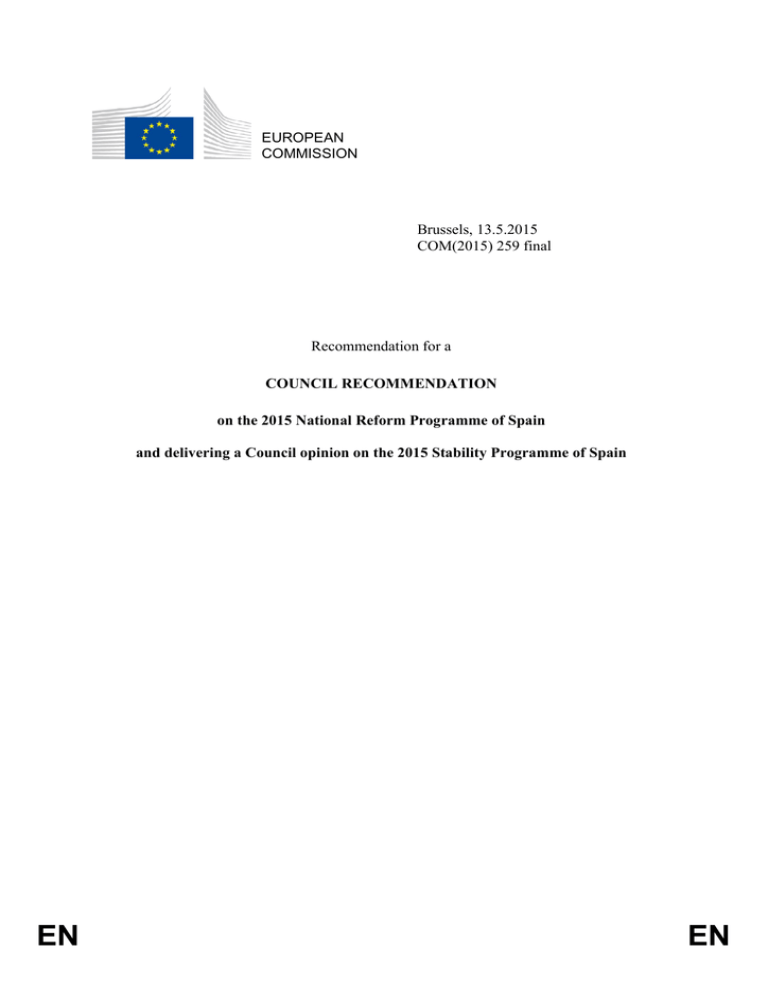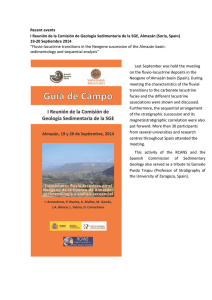Council recommendation on the 2015 National Reform Programme
Anuncio

EUROPEAN COMMISSION Brussels, 13.5.2015 COM(2015) 259 final Recommendation for a COUNCIL RECOMMENDATION on the 2015 National Reform Programme of Spain and delivering a Council opinion on the 2015 Stability Programme of Spain EN EN Recommendation for a COUNCIL RECOMMENDATION on the 2015 National Reform Programme of Spain and delivering a Council opinion on the 2015 Stability Programme of Spain THE COUNCIL OF THE EUROPEAN UNION, Having regard to the Treaty on the Functioning of the European Union, and in particular Articles 121(2) and 148(4) thereof, Having regard to Council Regulation (EC) No 1466/97 of 7 July 1997 on the strengthening of the surveillance of budgetary positions and the surveillance and coordination of economic policies1, and in particular Article 5(2) thereof, Having regard to Regulation (EU) No 1176/2011 of the European Parliament and of the Council of 16 November 2011 on the prevention and correction of macroeconomic imbalances2, and in particular Article 6(1) thereof, Having regard to the recommendation of the European Commission3, Having regard to the resolutions of the European Parliament4, Having regard to the conclusions of the European Council, Having regard to the opinion of the Employment Committee, Having regard to the opinion of the Economic and Financial Committee, Having regard to the opinion of the Social Protection Committee, Having regard to the opinion of the Economic Policy Committee, Whereas: (1) On 26 March 2010, the European Council agreed to the Commission’s proposal to launch a new strategy for growth and jobs, Europe 2020, based on enhanced coordination of economic policies. The strategy focuses on the key areas where action is needed to boost Europe’s potential for sustainable growth and competitiveness. (2) On 13 July 2010, the Council, on the basis of the Commission’s proposals, adopted a recommendation on the broad guidelines for the economic policies of the Member States and the Union (2010 to 2014) and on 21 October 2010 it adopted a decision on guidelines for the employment policies of the Member States. Together these form 1 2 3 4 EN OJ L 209, 2.8.1997, p. 1. OJ L 306, 23.11.2011, p. 25. COM(2015) 259. P8_TA(2015)0067, P8_TA(2015)0068, P8_TA(2015)0069. 2 EN the ‘integrated guidelines’ which Member States were invited to take into account in their national economic and employment policies. (3) On 8 July 2014, the Council adopted a recommendation on Spain’s National Reform Programme for 2014 and delivered its opinion on Spain’s updated Stability Programme for 2014. On 28 November 2014, in line with Regulation (EU) No 473/20135, the Commission presented its opinion on Spain’s draft budgetary plan for 20156. (4) On 28 November 2014, the Commission adopted the Annual Growth Survey7, marking the start of the 2015 European Semester of economic policy coordination. On the same day, on the basis of Regulation (EU) No 1176/2011, the Commission adopted the Alert Mechanism Report8, in which it identified Spain as one of the Member States for which an in-depth review would be carried out. (5) On 18 December 2014, the European Council endorsed the priorities for boosting investment, accelerating structural reforms and pursuing responsible growth-friendly fiscal consolidation. (6) On 26 February 2015, the Commission published its 2015 country report for Spain9. This assessed Spain’s progress in addressing the country-specific recommendations adopted on 8 July 2014. The country report also includes the results of the in-depth review under Article 5 of Regulation (EU) No 1176/2011. The Commission’s analysis leads it to conclude that Spain is experiencing macroeconomic imbalances which require decisive policy action and specific monitoring. In particular, despite some improvement in current account rebalancing, risks related to the high levels of private- and public-sector indebtedness and the highly negative net international investment position continue to merit close attention in a context of very high unemployment. The need for action to reduce the risk of adverse effects on the Spanish economy and, given its size, of negative spillover effects affecting the economic and monetary union, is particularly important. (7) On 30 April 2015, Spain submitted its 2015 National Reform Programme and its 2015 Stability Programme. To take account of their interlinkages, the two programmes have been assessed at the same time. (8) Spain is currently in the corrective arm of the Stability and Growth Pact. In its 2015 Stability Programme, the government plans an improvement in the headline deficit to 4.2 % of GDP in 2015 and gradually to 2.8% of GDP in 2016. The government plans to reach the medium-term objective of a balanced budgetary position in structural terms in 2019. According to the Stability Programme, the government debt-to-GDP ratio is expected to peak in 2015 at 98.9% and to gradually decline to 93.2% in 2018. The macroeconomic scenario underpinning these budgetary projections is plausible for 2015 and favourable thereafter. Based on the Commission's 2015 spring forecast, a deficit of 4.5% and 3.5% of GDP is foreseen for 2015 and 2016, respectively. Hence, there is a risk that the headline deficit targets for 2015 and 2016 may not be reached. Moreover, the projected fiscal effort by Spain over 2013-2016 is expected to be below the recommended level, and further structural measures will be needed 5 6 7 8 9 EN OJ L 140, 27.5.2013, p. 11. C(2014) 8804 final COM(2014) 902. COM(2014) 904. C(2014) 8804 final.. 3 EN in 2015 and 2016. Based on its assessment of the Stability Programme and taking to account the Commission's 2015 spring forecast, the Council is of the opinion that there is a risk that Spain will not comply with the provisions of the Stability and Growth Pact. Spain made some progress on eliminating public-sector commercial arrears. In 2014, Spain also made some progress on identifying proposals to rationalise healthcare, education, and social spending at regional level, although these were not finally adopted. However, draft legislation to introduce a spending rule on pharmaceutical and healthcare regional spending is currently before parliament. EN (9) Implementation of the preventive, corrective and enforcement measures contained in the Organic Law on Budget Stability and Financial Sustainability is progressing slowly. Cost-effectiveness in the healthcare sector has improved, but it remains essential to keep the growth of pharmaceutical expenditure under control and, specifically, to monitor pharmaceutical expenditure in hospitals. The deficit in the electricity system has been effectively eliminated as of 2014 and the problem of insolvent toll motorways has been addressed, thus reducing costs for the state. Spain has not, however, put in place a system for conducting independent assessments of major future infrastructure projects. (10) Some progress was made in the area of taxation, with a comprehensive tax reform being introduced to make the tax system simpler and more conducive to growth and job creation. A tax reform was adopted on 20 November 2014, to enter into force in January 2015, and covers personal and corporate income taxation. Some progress was also made with regard to the fight against tax evasion, but no progress was seen in the area of environmental taxation. The restructuring of the Spanish banking sector, and in particular of banks having received state aid, is progressing well. At the same time, recent measures to promote access to non-bank financing have — at least to some extent — improved access to finance for firms, especially in view of the high level of dependence of Spanish firms on credit from banks. Full implementation of these reforms is crucial for facilitating the reallocation of resources and supporting the ongoing adjustment. Outstanding problems not addressed by the reforms introduced to date also need to be tackled. Some progress was made in removing the remaining bottlenecks in the system for handling corporate insolvencies and a Royal Decree-Law on personal insolvency was adopted on 27 February 2015. However, further improvements to the administrative and judicial capacity for handling insolvency cases remain necessary. (11) High long-term unemployment and labour market segmentation continue to hamper productivity growth and have a damaging effect on working conditions in Spain. The social partners are discussing a comprehensive inter-professional agreement for 2015-2017. In this regard, and given the very high unemployment rate, wages for some sectors and companies in the short term may need to grow below productivity in order to create jobs and achieve further gains in competitiveness. It is expected that this may emphasise the importance of establishing, through sectoral and company negotiations, the principle that wages should move in line with inter-firm productivity differentials. Despite regulatory reforms, the proportion of the workforce in temporary employment began to increase once again in 2014, reaching over 24 %, and particularly affecting young people and the low-skilled. Moreover, the new types of contract introduced and the incentives to encourage employers to take on staff on an open-ended basis appear not yet to be being used to full potential. The Spanish authorities announced that an assessment of the subsidies offered to 4 EN employers for recruiting new staff would be carried out by May 2016. The capacity of the public employment service, and of the agencies to which services have been outsourced, is crucial for ensuring the effectiveness and adequate targeting of active labour market and activation policies, including effective re-training to allow people to move into sectors where more jobs are being created. Spain has made limited progress in accelerating the modernisation of public employment services and addressing regional disparities. EN (12) Youth unemployment in Spain remains very high (over 53 %)and the early school leaving rate is one of the highest in the EU. Spain is implementing the new educational schemes introduced by Law No 8/2013 on the quality of education, designed to increase the quality of primary and secondary education. Limited progress was made in increasing the labour-market relevance of vocational education and training, and the efforts to improve cooperation between higher education institutions and employers are behind schedule. There are plans to extend the dual vocational training scheme in 2015, but there continue to be considerable differences in its implementation across the regions. A dedicated committee has been set up to examine the relevance of education and training curricula to labour market needs. (13) Spain made limited progress on improving the effectiveness of its social protection system. It has established a new activation programme for the long-term unemployed, combining income support and assistance in looking for work. Limited coordination between the employment and social services, and the incompatibility of the different minimum income schemes have, however, reduced the effectiveness of the social assistance programmes. Facing high levels of poverty, especially among low-income households with children, Spain made limited progress in improving the targeting of family support schemes and care services. (14) Structural reforms need to include removing the obstacles preventing businesses from growing, helping SMEs in expanding their markets and promoting innovation, boosting export capacity, stimulating job creation, and help companies to compete more efficiently — including in internal markets — and improving overall productivity. Spain has begun to examine the reasons behind the high proportion of small and micro enterprises in its economy. Studying the reasons why businesses have remained small will allow the government to remove regulatory obstacles preventing firms from growing. Although some progress was made in implementing Law No 20/2013 on market unity, there are still delays at regional government level. The law on the regulation of environmental permits has not yet been implemented by all regions. No progress has been made with regard to the adoption of the reform of professional services and professional associations. Structural weaknesses in its research and innovation system continue to limit Spain’s growth potential. It therefore remains essential to identify new sources of funding, ensure effective and efficient use of resources, set up the new research agency and promote measures to make the business environment more innovation-friendly. (15) Some progress was made in relation to the rail network, with measures being taken to ensure effective competition in freight and passenger rail services. On 4 July 2014, the Council of Ministers adopted Royal Decree-Law 8/2014, creating a fund to improve the land accessibility of seaports. (16) Spain made progress in implementing the recommendations of the committee for the reform of public administration at all levels of government. It is, however, mainly at national level that the effects of the reform, in terms of efficiency gains and fiscal 5 EN savings, have been visible to date. Important steps were taken to improve the transparency of administrative decisions, but no progress was made in strengthening supervisory systems, in particular in public procurement at regional and local level. No measures have been taken to strengthen supervisory powers in public procurement and urban planning. Limited progress was made with regard to the adoption of judicial reforms aimed at improving the effectiveness of the justice system: draft laws on the judiciary and on civil procedure, which include some reforms, were submitted to Parliament on 27 February 2015; draft bills on legal aid and on voluntary jurisdiction are subject to parliamentary procedure. Some progress was made in implementing the reforms that have been adopted, including the Oficina Judicial, the reform introducing the digitisation of justice and improving the interoperability of regions’ electronic case management systems. Efforts need to be continued in this area. (17) In the context of the European Semester, the Commission has carried out a comprehensive analysis of Spain’s economic policy and published it in the 2015 country report. It has also assessed the Stability Programme and the National Reform Programme and the follow-up given to the recommendations addressed to Spain in previous years. It has taken into account not only their relevance for sustainable fiscal and socioeconomic policy in Spain but also their compliance with EU rules and guidance, given the need to strengthen the overall economic governance of the European Union by providing EU-level input into future national decisions. The recommendations under the European Semester are reflected in recommendations 1 to 4 below. (18) In the light of this assessment, the Council has examined Spain’s Stability Programme, and its opinion10 is reflected in particular in recommendation 1 below. (19) In the light of the Commission’s in-depth review and this assessment, the Council has examined the National Reform Programme and the Stability Programme. The recommendations under Article 6 of Regulation (EU) No 1176/2011 are reflected in recommendations 1 to 4 below. (20) In the context of the European Semester, the Commission has also carried out an analysis of the economic policy of the euro area as a whole. On the basis of this analysis, the Council has issued specific recommendations for the Member States whose currency is the euro. Spain should also ensure the full and timely implementation of these recommendations, HEREBY RECOMMENDS that Spain take action in 2015 and 2016 to: 1. Ensure a durable correction of the excessive deficit by 2016 by taking the necessary structural measures in 2015 and 2016 and using windfall gains to accelerate the deficit and debt reduction. Strengthen transparency and accountability of regional public finances. Improve the cost-effectiveness of the healthcare sector, and rationalise hospital pharmaceutical spending. 2. Complete the reform of the saving banks’ sector, including by means of legislative measures, and complete the restructuring and privatisation of state owned savings banks. 10 EN Under Article 5(2) of Council Regulation (EC) No 1466/97. 6 EN 3. Promote the alignment of wages and productivity, in consultation with the social partners and in accordance with national practices, taking into account differences in skills and local labour market conditions as well as divergences in economic performance across regions, sectors and companies. Take steps to increase the quality and effectiveness of job search assistance and counselling, including as part of tackling youth unemployment. Streamline minimum income and family support schemes and foster regional mobility. 4. Remove the barriers preventing businesses from growing, including size-contingent regulations; adopt the planned reform on professional services; accelerate the implementation of the law on market unity. Done at Brussels, For the Council The President EN 7 EN







